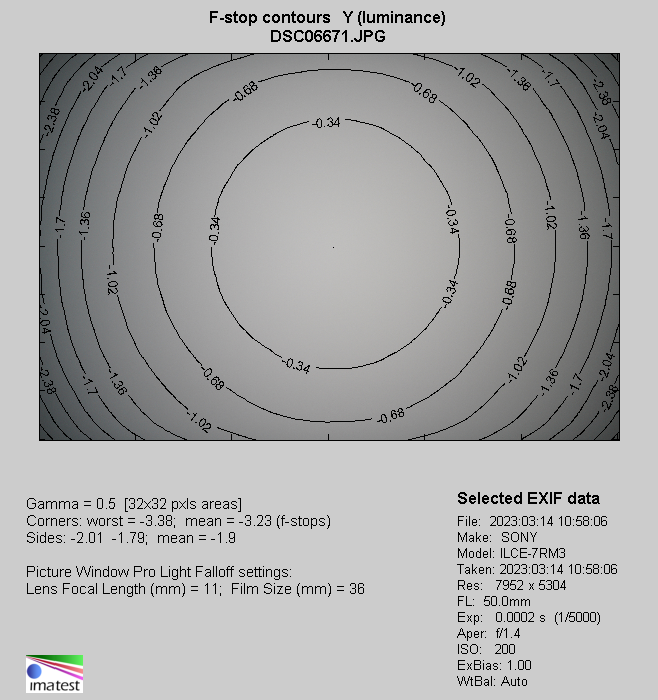Sigma A 50 mm f/1.4 DG DN
8. Vignetting
| A7R III, APS-C, f/1.4 | A7R III, APS-C, f/2.0 |

|

|
At the maximum relative aperture vignetting is noticeable as it reaches a level of 30% (−1.05 EV). Fotunately it is not a high value. Problems end very quickly, though, because by f/2.0 this aberration decreases to 16% (−0.50 EV). What's more, by f/2.8 it drops further to a quite imperceptible level of 8% (−0.25 EV).
Please Support UsIf you enjoy our reviews and articles, and you want us to continue our work please, support our website by donating through PayPal. The funds are going to be used for paying our editorial team, renting servers, and equipping our testing studio; only that way we will be able to continue providing you interesting content for free. |
- - - - - - - - - - - - - - - - - - - - - - - - - - - - - - - - - - - - - - - - - - - - - - - -
After passing to the bigger full frame sensor there are far more problems and they become quite conspicuous. Just look at photos below.
| A7R III, FF, f/1.4 | A7R III, FF, f/2.0 |

|

|
| A7R III, FF, f/2.8 | A7R III, FF, f/4.0 |

|

|
At the maximum relative aperture we got a very high result, that of 67% (−3.23 EV). The new Sigma definitely didn't do a good job here. Let's just say for the comparison's sake that its reflex camera equivalent had a noticeably better result of 43%. Still, while we can understand defeat in a duel with its predecessor, after all vignetting correction in case of mirrorless constructions is more difficult, we don't understand at all why Sigma had to lose to the significantly smaller and lighter Sony FE 50 mm f/1.4 GM. The Sony's vignetting amounted to 63%. Taking dimensions of the Sigma A 50 mm f/1.4 DG DN we expected results much closer to 50%. Unfortunately, the performance in this category is a serious failure.
Especially that the vignetting problem remains acute even on stopping down. By f/2.0 we got a result of 50% (−2.02 EV), and by f/2.8 it is still 45% (−1.75 EV).Also by f/4.0 and f/5.6 you won't have the slightest problem with noticing brightness loss in the frame corners, as it amounts to, respectively, 41% (−1.53 EV) and 36% (−1.29 EV). Even applying f/8.0 and f/11.0 doesn't guarantee you get rid of vignetting completely, as this aberration still reaches 33% (−1.16 EV) and 30% (−1.02 EV).
The performance in this category is really a serious slip-up. Significant physical dimensions of Art line lenses are understandable as they help to correct most of optical aberrations. Still, if you get a big, heavy lens that corrects vignetting much weaker than smaller and lighter devices, it's very difficult to understand and explain such an approach.
| Sony A7R III, JPEG, f/1.4 |
 |






